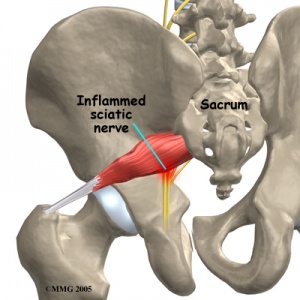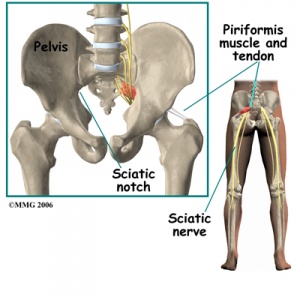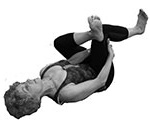Sciatica / Piriformis Syndrome / Hip Issues
[clear] [one_half] Sciatica is a condition where the bony structure of the lumbar spine at L4 and down to the sacral bones at S1 have inflamed the nerve routes affecting the sciatic nerve path as it exits the buttocks. Common causes of Sciatica are:
- Stenosis
- Osteopathic
- Spinal Fusion
- Bursitis
- Osteoporosis
- Facet Disruption
- Herniated Discs
- Repetitive Movement Syndromes
Piriformis Syndrome occurs when the sciatic nerve is compressed causing pain, tingling, or numbness in the buttocks and down the leg. Piriformis Syndrome occurs when there is sciatica present without a clear spinal cause.
[/one_half] [one_half_last]
image: www.orthopod.com
Yoga practices with weak and/or tight low back muscles may aggravate the condition in straight-legged forward bends.
Inactiive or deconditioned gluteus muscles may cause the syndrome to develop. A major cause for inactive gluteus maximus and medius is overactive hip flexors. [Psoas Major, Iliacus, and Rectus Femorus]
This imbalance occurs when the hip flexors are over trained and become too short and tight; as in when someone sits with hips flexed all day at work or runners and cyclists repetitive motion. This deprives the gluteals of activation and the hamstrings, adductors, and piriformis muscles have to perform extra roles they were not designed to do. The result is swelling of the piriformis that produces sciatica symptoms.
Runners, cyclists, and athletes engaging in forward-moving activity are susceptible to piriformis syndrome if they do not engage in lateral stretching and strengthening exercises.
Weak outer thighs and hip muscles combined with tight inner thigh muscles can cause the piriformis muscle to shorten and severely contract.
Another cause for piriformis syndrome may be stiffness of the sacroiliac joint. This changes the walking gait and can result in sheering the origin of the piriformis causing malfunction and low back pain.
Over pronation of the foot causes the knee to turn medially causing the piriformis to activate and cause knee to over rotate, resulting in overuse of the piriformis muscle, thus leading to piriformis syndrome.
Lastly, the most frequently associated cause is a falling injury.
Treatment generally begins with stretching exercises and massage and avoidance of contributing activities. Physical therapy, stretching techniques, and strengthening core muscles reduce strain on the piriformis. Check with your doctor who may require an MRI to accurately diagnose sciatica and piriformis syndrome. Depending on your diagnosis, your doctor may recommend alternating ice and heat, steroid injections, corrective shoes, or anti-inflammatory drugs. Alternative therapies may be indicated, such as Rolling on soft foam roller (myofascial release) massage, acupuncture and ultrasound.
The following yoga poses may help release the hip flexors. A regular backbend practice in the presence of a knowledgeable teacher who can check your alignment may alleviate your pain.
[clear]- Virasana
- Hurdler
- Lord of the Fish
- Bridge
- Table Top
- Happy Baby
- Half Camel
- Camel
- Eastern Plank
- Chair Backbend
- Spinal Twist
- Cobbler
- Thunderbolt
- Thread the Needle
- Roller Quads












